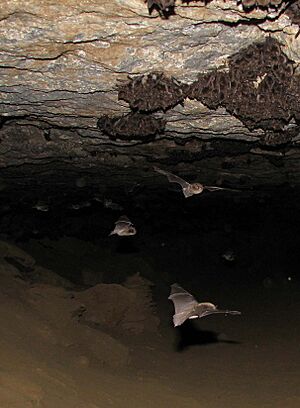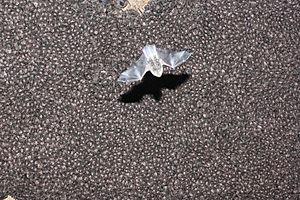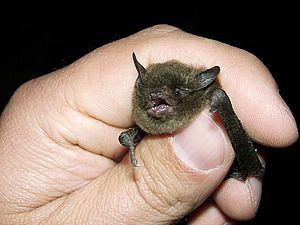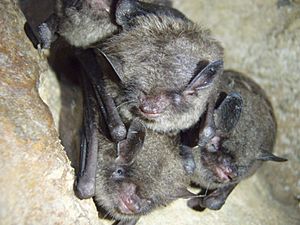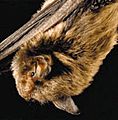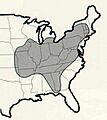Indiana bat facts for kids
Quick facts for kids Indiana bat |
|
|---|---|
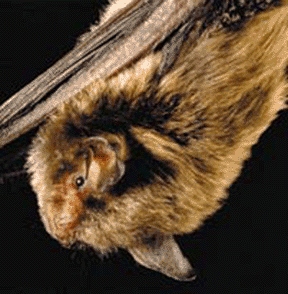 |
|
| Conservation status | |
| Scientific classification | |
| Genus: |
Myotis
|
| Species: |
sodalis
|
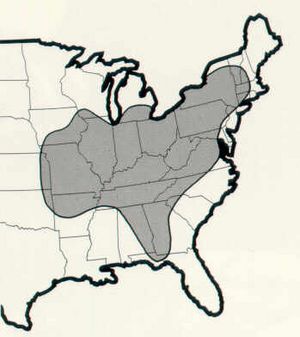 |
|
| Approximate range of the Indiana bat | |
The Indiana bat (Myotis sodalis) is a medium-sized mouse-eared bat that lives in North America. You can find it mostly in the Southern and Midwestern parts of the U.S. This bat is an endangered species, meaning its population is very low.
Indiana bats are usually gray, black, or chestnut brown. They are about 1.2 to 2.0 inches (3 to 5 cm) long and weigh about 0.16 to 0.34 ounces (4.5 to 9.5 grams). They look a lot like the more common little brown bat. However, you can tell an Indiana bat apart by its foot size, the length of the hairs on its toes, its pink lips, and a small ridge called a keel on its calcar (a cartilage spur near the foot).
These bats live in forests with hardwood trees, or a mix of hardwood and pine trees. They are often found in old-growth forests and on farms, especially in wooded areas, crop fields, and grasslands. Indiana bats are insectivores, which means they eat insects. They hunt flying insects like moths, beetles, mosquitoes, and midges.
The U.S. Fish and Wildlife Service lists the Indiana bat as an endangered species. Its population has dropped by more than 50% in the last 10 years. This decline is based on direct observations and how much their living area has shrunk.
Contents
- What Does the Indiana Bat Look Like?
- Where Do Indiana Bats Live?
- Why Are Indiana Bats Endangered?
- What Are the Current Threats to Indiana Bats?
- What Plants Do Indiana Bats Use?
- Major Life Events and Reproduction
- Where Do Indiana Bats Live in Summer and Winter?
- What Do Indiana Bats Eat?
- Who Are the Predators of Indiana Bats?
- Images for kids
- See also
What Does the Indiana Bat Look Like?
The Indiana bat's body, from its head to its rear, is about 1.6 to 1.9 inches (4.1 to 4.9 cm) long. This animal weighs about a quarter of an ounce (7 grams). It can be very hard to tell these bats apart from other species, especially the common little brown bat (Myotis lucifugus). You need to look very closely to see the differences.
Scientists use a few key features to identify Indiana bats. These include the size of their feet, the length of the hairs on their toes, and a special ridge called a keel on their calcar. Indiana bats usually live for 5 to 9 years, but some have lived up to 12 years. Their fur can be black to chestnut brown, with a light gray to cinnamon-colored belly. Unlike other common bats that have brown fur and black lips, Indiana bats have brown fur and pink lips. This helps scientists tell them apart.
Where Do Indiana Bats Live?
Indiana bats spend their summers across the eastern United States. But in winter, they gather in large groups and hibernate in just a few caves. Since about 1975, their population has gone down by about 50%. A count in 1985 estimated there were around 244,000 Indiana bats hibernating. About 23% of these bats hibernate in caves in Indiana.
Indiana bats only live in caves during the winter. However, only a few caves have the right conditions for them to hibernate. They need stable, low temperatures. This helps the bats slow down their bodies and save their fat reserves. These bats hibernate in big, tight groups that can have thousands of individuals. Indiana bats eat only flying insects at night. A colony of bats can eat millions of insects every night! The area where Indiana bats live also overlaps with the gray bat (Myotis grisescens), which is also an endangered species.
Why Are Indiana Bats Endangered?
The Indiana bat was first listed as federally endangered in 1967. This was because their numbers were dropping quickly across all the areas where they live. There are several reasons for this decline.
- Human disturbance: People bothering bat colonies.
- Pesticide use: Chemicals used to kill insects can harm bats.
- Loss of summer homes: Forests are being cut down, which means fewer places for bats to live in summer.
Since 1973, the Indiana bat has been protected by the Endangered Species Act. The Federal Cave Resources Protection Act of 1988 also helps protect the caves where they hibernate on federal lands. In 2013, Bat Conservation International put the Indiana bat on its list of 35 top priority species for conservation worldwide.
What Are the Current Threats to Indiana Bats?
Indiana bat populations in the northeastern U.S. are facing a huge threat from white-nose syndrome. This is a terrible disease that has killed millions of bats since it was first found in 2007. By the end of 2011, this disease had killed between 5.7 and 6.7 million bats in the United States. At least 15,662 Indiana bats died from white-nose syndrome in 2008 alone. In Pennsylvania, an estimated 95% of all cave bats have died from it.
Sadly, some people have directly harmed or killed Indiana bats. For example, in 2007, two men in Kentucky entered a cave and killed 105 endangered Indiana bats. They used flashlights and rocks to knock hibernating bats off their roosts and crushed them. Bats that tried to fly away were also knocked down. The men admitted to knowingly killing an endangered species. This incident was called a "senseless killing" by officials. The men were found guilty of breaking the federal Endangered Species Act. One man was sentenced to eight months in federal prison, and the other received three years of probation. This was the first time people were sentenced for killing endangered Indiana bats.
Another threat is wind turbines. Indiana bats have died from flying into wind turbines. This can happen from direct hits with the blades or from changes in air pressure (barotrauma). As of 2013, five Indiana bat deaths were confirmed at wind farms. Some estimates suggest that up to 63.9 bats per turbine could die each year.
Other human activities have also caused Indiana bat populations to drop. These include:
- Using pesticides.
- People disturbing bats in their winter homes (hibernacula).
- Building improper gates on caves.
- Climate change.
- Developing land for farming.
Because of these issues, the Indiana bat population across the country fell by 57% between 1960 and 2001.
What Plants Do Indiana Bats Use?
Indiana bats use many different types of trees in their habitats. Common trees include oaks (Quercus spp.), hickories (Carya spp.), ashes (Fraxinus spp.), and maples (Acer spp.). They also use plants like hawthorns (Crataegus spp.), dogwoods (Cornus spp.), and wild grape (Vitis spp.).
In different areas, the specific plants they use can vary. For example, in southern Iowa, they were found in areas with eastern cottonwood, hackberry, and silver maple. In other parts of Iowa, they used black oak and shagbark hickory.
Indiana bats use at least 29 different tree species during the summer. This suggests that the type of tree isn't the only important thing for their habitat. They need a variety of trees to choose from.
Major Life Events and Reproduction
Indiana bats start arriving at their winter homes, called hibernacula (caves and mines), in late August. Most are back by September. Females go into hibernation soon after they arrive. Males stay active longer, until late autumn, to breed with females who arrive later. Most Indiana bats hibernate from October to April. However, in the northern parts of their range, they might hibernate from September to May.
Sometimes, Indiana bats hibernate alone, but usually they form very dense clusters. These clusters can have thousands of bats packed together.
Spring migration can start as early as late March. But most Indiana bats don't leave their winter homes until late April or early May. Females usually emerge first, between late March and early May. Most males don't start to emerge until mid- to late April. Females arrive at their summer locations starting in mid-April.
During the summer, females form "nursery colonies" where they raise their young. These colonies can have up to 100 adult females. Males usually roost alone or in small groups during the summer. Many males stay near their winter hibernacula, while others travel to different areas, similar to where females go.
Females can mate in their first autumn, but some wait until their second year. Males become ready to reproduce in their second year. Mating happens in and around the hibernacula in the fall. During the breeding season, Indiana bats do something called "swarming." This is when many bats fly in and out of caves from sunset to sunrise. Swarming mostly happens from August to September and is an important part of mating. Bats have been seen mating in caves until early October. During this swarming and breeding time, very few bats are found resting inside the hibernacula during the day. Some mating might also happen at the end of hibernation.
Fertilization doesn't happen until the end of hibernation. The pregnancy lasts about 60 days. Baby bats are born in late May to early July. Female Indiana bats usually give birth to one pup. Young bats are weaned (stop drinking milk) after 25 to 37 days. They can also fly around this time. Most young bats can fly by early to late July, but sometimes not until early August.
Indiana bats live a relatively long time. One Indiana bat was caught 20 years after it was first tagged as an adult! Other tagged bats show that females can live at least 14 years and 9 months, while males can live for at least 13 years and 10 months.
Where Do Indiana Bats Live in Summer and Winter?
Scientists are still learning everything about what Indiana bats need for their homes. At first, people thought that forests near rivers were most important in summer. But later studies showed that forests on higher ground are just as important, especially in the southern areas where they live. Indiana bats are found in hardwood forests across most of their range. In the southeastern U.S., they live in mixed hardwood-pine forests.
In one study in Illinois, the area where Indiana bats were found was mostly farmland (about 67%). About 30% was forest on higher ground, and 2.2% was forest near floodplains. Only a tiny bit (0.1%) was water. In southern Michigan, the areas where Indiana bats lived included open fields and farms (55%), wetlands and lowland forests (19%), other forests (17%), developed areas (6%), and water sources like ponds and streams (3%).
Even though much of the land where Indiana bats live is covered by farms and open areas, the bats usually don't use these open spaces.
Indiana bats typically spend the winter in caves or mines. However, a few bats have been found hibernating on a dam in northern Michigan. They need very specific conditions to survive the winter hibernation period, which lasts about 6 months. As the temperature inside a hibernaculum changes during winter, Indiana bats sometimes fly to different spots inside the cave to find the best conditions. They might even move between nearby hibernacula to find the right place to hibernate. Indiana bats usually return to the same hibernacula or nearby areas they've used before. The U.S. Fish and Wildlife Service has marked important winter homes for Indiana bats. These include 13 hibernacula in Illinois, Indiana, Kentucky, Missouri, Tennessee, and West Virginia.
Hibernacula are grouped into three types based on how many bats use them each year:
- Priority one: These caves consistently have more than 30,000 Indiana bats hibernating each winter.
- Priority two: These caves have 500 to 30,000 bats.
- Priority three: These caves have fewer than 500 bats.
It's thought that at least 50% of Indiana bats hibernate in the eight priority one hibernacula. These are found in Indiana (three), Missouri (three), and Kentucky (two). Counts from 2001 showed that priority one hibernacula had 48% fewer bats than in 1983. Overall, populations have dropped by about 57% since 1960 across all hibernacula.
Summer Roosts: Where Bats Rest During the Day
Scientists have found that Indiana bats use at least 29 different tree species for roosting (resting) during the summer and during their spring and fall travels. Since they use so many types of trees, the specific tree species probably isn't the only important thing. Besides trees, Indiana bats have also used a church attic, a utility pole, and bat boxes as roosts. However, using human-made structures seems to be rare. Female bats might choose their roosts based on things like weather. Cool temperatures can slow down the development of their babies, so choosing roosts with the right conditions is very important for them to have healthy young.
There are two types of day roosts that Indiana bats use:
- Primary roosts: These usually hold more than 30 bats at a time and are used most often by a group of mother bats and their young (a maternity colony).
- Alternate roosts: These are trees that hold smaller numbers of Indiana bats from the same maternity colony.
Maternity colonies might use up to three primary roosts and as many as 33 alternate roosts in one season. Female bats that are reproducing often switch roosts to find the best conditions. When they move between day roosts, Indiana bats might travel as little as 23 feet (7 m) or as far as 3.6 miles (5.8 km). Usually, their moves are short, less than 0.6 miles (1 km).
Primary roosts are most often found at the edges of forests or in gaps in the tree canopy. Alternate roosts are generally located in a shaded part of the forest interior, and sometimes at the forest edge.
The amount of tree cover (canopy cover) at a roost can vary. Some studies say bats need low cover, while others show they use trees with moderate to high cover, even completely closed canopies. A general pattern is that primary roosts are in areas with low cover, while alternate roosts tend to be more shaded.
Foraging: Where Bats Find Food
Studies on where Indiana bats find food are still being figured out. Bats hunt in areas with pastures, corn fields, small woods, and strips of forest along rivers.
Bat activity is often focused around small gaps in the tree canopy or under dense forest canopies along small streams. Indiana bats have been seen hunting in forests on higher ground, as well as in areas near rivers, like forest edges along floodplains. They rarely use open farm fields, pastures, or open water for traveling or hunting.
The distance an individual Indiana bat travels between its day roost and its nightly hunting area can vary. Indiana bats have traveled up to 1.6 miles (2.6 km) from their day roosts to their hunting spots in Illinois. In Kentucky, they traveled up to 1.5 miles (2.4 km) to hunt. In Michigan, female bats traveled as far as 2.6 miles (4.2 km) to reach their hunting areas.
Indiana bats hunt at different heights. In Indiana, they hunted around the top of the trees, from 7 to 98 feet (2 to 30 m) above the ground. In Missouri, a female bat hunted 7 to 33 feet (2 to 10 m) above a river. A male Indiana bat was seen flying in circles among trees at 10 to 33 feet (3 to 10 m) above the ground under dense forest.
The size of their hunting areas also varies. Bats from the same colony might hunt in different areas. The average hunting area for female bats in Indiana was 843 acres (341 ha), but for males, it was much larger, averaging 6,837 acres (2,767 ha).
Winter Homes: Hibernacula Conditions
During hibernation, Indiana bats prefer open areas on the ceilings of caves and mines. They usually avoid cracks and enclosed spaces. They like hibernacula that are long (about 2,817 feet or 858 m), have high ceilings (about 15 feet or 4.5 m), and large entrances (about 104.4 square feet or 9.7 m2). The best hibernacula often have several entrances, which helps air flow through. The choice of a hibernaculum might also depend on whether the surrounding area has enough food for them when they arrive. Having forests around the cave entrance and not too much open farmland can be important.
The ability for Indiana bats to find good hibernating conditions is very important for their survival. If a hibernaculum stays too warm during winter, it can cause many bats to die. They usually hibernate in warmer parts of the cave in the fall, then move to cooler areas as winter goes on.
Temperatures just above freezing during hibernation allow Indiana bats to slow down their bodies as much as possible. This helps them save energy without freezing to death or using up their fat too quickly. Hibernating bats might also survive low temperatures by sharing body heat in the tight clusters they form. Bats wake up sometimes during hibernation, perhaps to go to the bathroom or move to a better spot. This natural waking doesn't seem to harm them. However, if they wake up because of people disturbing them, it can make them use a lot of energy. This can cause them to run out of fat reserves before winter ends, which can lead to death.
One way caves stay cold is by letting in cold air from outside. Caves with the largest bat populations usually have multiple entrances. These entrances allow cool air to come in, creating a flow of fresh, cool air. Gates put up to keep people out of caves have sometimes changed the temperature and airflow inside. This has caused Indiana bat populations to decline in many major hibernacula. Removing or changing these gates has helped some populations recover. Bats also seem to prefer a humidity level of 74% to 100%.
What Do Indiana Bats Eat?
Indiana bats eat only flying insects that live on land or in water. Their most common prey are moths (Lepidoptera), beetles (Coleoptera), and mosquitoes and midges (Diptera). What they eat depends a lot on what insects are available in their hunting area. Their diet can change with the seasons, depending on whether females are raising young, and even from night to night.
In southern Michigan, Indiana bats mainly ate caddisflies (Trichoptera) and bees, wasps, and ants (Hymenoptera), in addition to the more common prey listed above. In the Ozarks of southern Missouri, the bats also mostly ate bees, wasps, ants, moths, and beetles, as well as leafhoppers (Homoptera). In Indiana, bats preferred beetles, moths, mosquitoes, midges, leafhoppers, and wasps. They also eat very small amounts of other insects like lacewings, spiders, stoneflies, mayflies, mites, ticks, and lice.
Who Are the Predators of Indiana Bats?
During hibernation, predators of Indiana bats can include black rat snakes (Pantherophis obsoletus) and northern raccoons (Procyon lotor). At other times of the year, raccoons have been seen trying to catch bats as they fly away. Skunks (Mephitidae), Virginia opossums (Didelphis virginiana), and feral cats (Felis catus) might also be a threat.
If Indiana bats fly from their day roosts during the day, they might be caught by hawks (Accipitridae). Indiana bats hunting at night could also be caught by owls (Strigidae). Woodpeckers (Picidae) are not predators, but they can disturb roosting bats. They might peel away bark that bats are using, causing the bats to fly out during the day. This can also make the tree unsuitable for bats later.
The impact of natural predators on Indiana bats is small compared to the harm caused by humans. This is especially true during hibernation. When people enter caves, it can cause Indiana bats to wake up from hibernation. This makes them use a lot of energy. By causing them to wake up and use their energy stores, humans can cause many bats in a hibernating colony to die. Human disturbance and the destruction of their homes are the main reasons for their decline.
Images for kids
See also
 In Spanish: Murciélago de Indiana para niños
In Spanish: Murciélago de Indiana para niños



